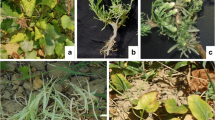Abstract
The diagnosis of plant diseases caused by Brevipalpus-transmitted viruses (BrTVs) has been done through the analyses of symptoms, transmission electron microscopy, and RT–PCR of infected plant tissues. Here, we report the detection of Citrus leprosis virus C, Orchid fleck virus, Clerodendrum chlorotic spot virus and Solanum violaefolium ringspot virus in their viruliferous vectors Brevipalpus spp. using specific primer pairs for each of the viruses. The efficiency of virus transmission by Brevipalpus mites is low, so the detection of these pathogens in their vectors could constitute an important tool for studies involving virus-vector relationships, transmission, and monitoring the pathogen prior to the appearance of symptoms in the field.



Similar content being viewed by others
References
Bassanezi RB, Laranjeira FF (2007) Spatial patterns of leprosis and its mite vector in commercial citrus groves in Brazil. Plant Pathol 56:97–106
Bastianel M, Novelli VM, Kitajima EW, Kubo KS, Bassanezi RB, Machado MA, Freitas-Astúa J (2010) Citrus Leprosis: Centennial of an Unusual Mite Virus Pathosystem. Plant Dis 94:284–292
Blanchfield AL, Mackenzie AM, Gibbs A, Kondo H, Tamada T, Wilson CR (2001) Identification of Orchid fleck virus by reverse transcriptase-polymerase chain reaction and analysis of isolate relationships. J Phytopathol 149:713–718
Boaretto MAC, Chiavegato LG (1994) Transmissão da leprose por ácaros Brevipalpus phoenicis (Geijskes, 1939) (Acari: Tenuipalpidae) temporariamente mantido sem hospedeirosintermediários em condições de laboratório. Científica 22:81–83
Boaretto MAC, Chiavegato LG, Silva CAD (1993) Transmissão da leprose através de fêmeas de Brevipalpus phoenicis (GEIJSKES, 1939) (Acari: Tenuipalpidae) e de seus descendentes, em condições de laboratório. Científica 21:245–253
Boari AJ, Freitas-Astúa J, Ferreira PTO, Neder DG, Nogueira NL, Rossi ML, Kitajima EW (2004) Purification and serology of the Coffee ringspot virus. Summa Phytopathol 30:453–458
Carstens EB (2010) Ratification vote on taxonomic proposals to the International Committee on Taxonomy of Viruses (2009). Arch Virol 155:133–146
Ferreira PTO, Locali EC, Freitas-Astúa J, Antonioli-Luizon R, Gomes RT, Machado MA, Kitajima EW (2007) Caracterização de um vírus baciliforme isolado de Solanum violaefolium transmitido pelos ácaros Brevipalpus phoenicis e Brevipalpus obovatus (Acari: Tenuipalpidae). Summa Phytopathol 33:264–269
Gibbs A, Mackenzie A (1997) A primer pair for amplifying part of the genome of all potyvirids by RT-PCR. J Virol Methods 63:9–16
Kitajima EW, Chagas CM, Rodrigues JCV (2003) Brevipalpus-transmitted plant virus and virus-like diseases: cytopathology and some recent cases. Exp Appl Acarol 30:135–160
Kitajima EW, Kubo KS, Ferreira PTO, Alcantara BK, Boari AJ, Gomes RT, Freitas-Astúa J, Rezende JAM, Moraes GJ, Salaroli RB (2008) Clerodendron chlorotic spot: a disease caused by a nuclear type of Brevipalpus (Acari: Tenuipalpidae)-transmitted virus. Sci Agric 65:36–49
Kitajma EW, Rodrigues JCV, Freitas-Astúa J (2010) An annotated list of ornamentals naturally found infected by Brevipalpus mite transmitted viruses. Sci Agric 67:348–371
Knorr LC (1968) Studies on the etiology of leprosis in citrus. Proc. IV Int. Conf. Org. Citrus Virol. 4:332–340. Riverside, CA
Kondo K, Maeda T, Shirako Y, Tamada T (2006) Orchid fleck virus is a rhabdovirus with an unusual bipartite genome. J Gen Virol 87:2413–2421
Kondo H, Maeda T, Tamada T (2003) Orchid fleck virus: Brevipalpus californicus mite transmission, biological properties and genome structure. Exp Appl Acarol 30:215–223
Kubo KS, Stuart RM, Freitas-Astúa J, Antonioli-Luizon R, Locali-Fabris EC, Coletta-Filho HD, Machado MA, Kitajima EW (2009) Evaluation of the genetic variability of Orchid fleck virus by single-strand conformational polymorphism analysis and nucleotide sequencing of a fragment from the coat protein gene. Arch Virol 154:1009–1014
Locali EC, Freitas-Astúa J, Souza AA, Takita MA, Astúa-Monge G, Antonioli R, Kitajima EW, Machado MA (2003) Development of a molecular tool for the diagnosis of leprosis, a major threat to citrus production in the Americas. Plant Dis 87:1317–1321
Novelli VM, Freitas-Astúa J, Bastianel M, Locali-Fabris EC, Antonioli-Luizon R, Ribeiro BM, Machado MA (2007) Detecção do vírus da leprose dos citros no ácaro vetor. Laranja 28:39–46
Acknowledgements
To FAPESP and Embrapa for partially supporting this work.
Author information
Authors and Affiliations
Corresponding author
Rights and permissions
About this article
Cite this article
Kubo, K.S., Novelli, V.M., Bastianel, M. et al. Detection of Brevipalpus-transmitted viruses in their mite vectors by RT–PCR. Exp Appl Acarol 54, 33–39 (2011). https://doi.org/10.1007/s10493-011-9425-9
Received:
Accepted:
Published:
Issue Date:
DOI: https://doi.org/10.1007/s10493-011-9425-9




